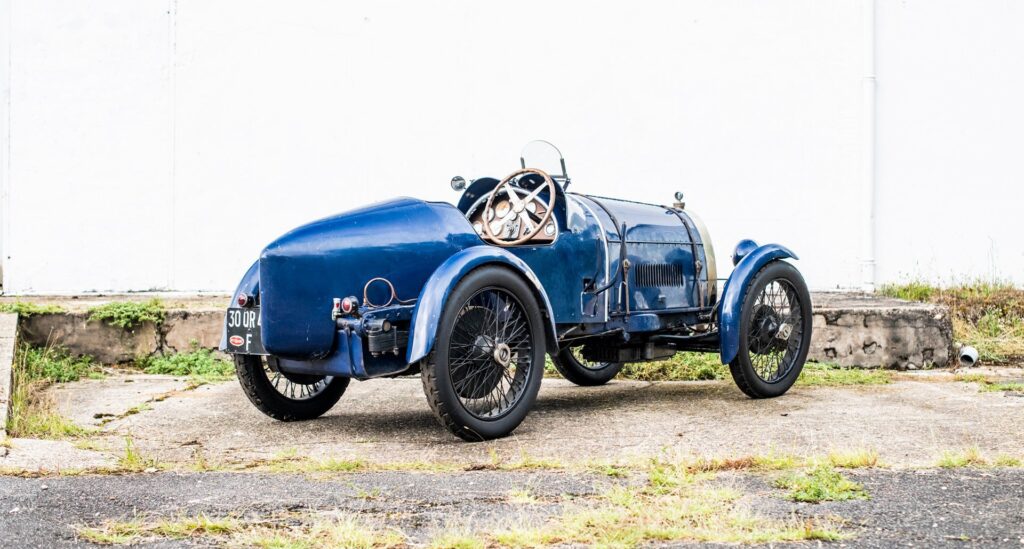The Bugatti Type 30, first produced in 1922, represents a seminal moment in automotive history and embodies the beginning of a new era for Bugatti as a manufacturer of cutting-edge, competition-ready vehicles. This particular Grand Prix Usine version, once owned by Mr. T, holds a unique place not only in Bugatti’s legacy but in the broader narrative of early motor racing. Acquired by Mr. T in 1981, the Type 30 Grand Prix model encapsulates the essence of engineering brilliance, design excellence, and performance-driven innovation, establishing a benchmark that would influence the trajectory of Bugatti’s racing pedigree. This essay critically examines the Bugatti Type 30’s technical specifications, historical significance, cultural impact, and its enduring legacy within the annals of motorsport.
The Genesis of the Type 30
The Bugatti Type 30 marked the company’s transition to 8-cylinder engine technology, a move that distinguished it as the first ‘production’ vehicle from the marque to feature such a powertrain. Its innovative engineering came as a direct response to the burgeoning demands of Grand Prix racing, where higher speeds, reliability, and agility were paramount. Designed by Ettore Bugatti himself, the Type 30 was equipped with a 2.0-liter, straight-8 engine that produced approximately 75 horsepower, an impressive output for its time.
The engine, based on Bugatti’s 3-valve-per-cylinder design, was revolutionary in its ability to provide smooth, linear power delivery, making it a favorite among racers and enthusiasts. The Type 30’s engine layout also featured an innovative roller-bearing crankshaft, a hallmark of Bugatti’s commitment to engineering excellence. This feature not only reduced friction but also improved engine durability, which was crucial in the high-stress environment of Grand Prix racing.
Aesthetically, the Type 30 adhered to Bugatti’s tradition of blending form and function, with its lightweight yet robust chassis allowing for nimble handling and sharp cornering. The model’s sleek, minimalistic bodywork reduced aerodynamic drag, while its characteristic ‘horseshoe’ radiator grille—a signature element in all subsequent Bugatti models—added a distinctive visual appeal. This fusion of mechanical prowess and artistic elegance defined the Type 30’s presence on the track, setting it apart from its contemporaries.
A Game-Changing Evolution
Before the Type 30’s debut, Bugatti had experimented with various configurations and designs, but it was with this model that the marque achieved a level of technical refinement suitable for mass production. The Type 30 was not merely an experimental prototype; it was Bugatti’s first serious attempt to produce a competitive Grand Prix car that could also serve as a basis for road-going variants.
The leap from prototype to production was significant for the company’s commercial and competitive ambitions. By creating a production model, Bugatti could leverage the lessons learned from racing to create vehicles with broader appeal, thus securing financial stability while cementing its reputation as a leader in automotive innovation. The Type 30 laid the groundwork for future icons like the Type 35, which would go on to dominate European racing circuits throughout the late 1920s and early 1930s.
The Type 30’s importance is further underscored by its role as a technological precursor to the Type 35. Both models shared the same basic engine architecture and chassis design, but the Type 30 served as a proving ground for new concepts that were refined and perfected in the Type 35. This lineage illustrates how Bugatti approached automotive design as an iterative process, each model building upon the strengths of its predecessor.
The Bugatti Type 30, particularly in its Grand Prix Usine configuration, was more than just a mechanical marvel—it was a cultural symbol of speed, precision, and exclusivity. In the early 1920s, the automotive world was still coming to grips with the potential of internal combustion engines. The Type 30’s debut on the racing circuit challenged existing notions of what a production car could achieve, and its success in competitions like the Targa Florio helped solidify Bugatti’s reputation as a force to be reckoned with.
It’s intent extended beyond racing circles. The Type 30 became a symbol of the Jazz Age’s fascination with technological advancement and modernity. Its ownership by Mr. T decades later reflects this ongoing allure, as discerning collectors and enthusiasts have long sought to preserve these rare machines not merely as relics of a bygone era but as living embodiments of automotive artistry.
Mr. T’s acquisition of the Type 30 Grand Prix Usine in 1981 is emblematic of the car’s enduring appeal to connoisseurs. His appreciation for the model speaks to its historical value and the respect it commands among those with an eye for significant automobiles. By the time of his purchase, the Type 30 had already achieved iconic status, its rarity and pedigree making it a prized addition to any collection. This particular vehicle, with its well-documented provenance and competitive history, stands as a testament to the lasting influence of Bugatti’s engineering vision.
Racing Thoroughbred
The Type 30 Grand Prix Usine was not content to merely look the part—it performed with exceptional vigor on the track. With a top speed of approximately 90 mph, it could keep pace with the fastest competitors of its day. Its lightweight chassis, combined with advanced suspension systems featuring semi-elliptic leaf springs at the front and rear, offered precise handling and impressive stability, even on the uneven surfaces that typified early racing circuits.
The car’s racing credentials were further enhanced by its success in events like the 1922 Grand Prix de Tourisme and subsequent appearances in various endurance races. Drivers praised the Type 30 for its responsiveness and balance, qualities that made it a formidable contender in a variety of competitive settings. The car’s agility, combined with its powerful yet reliable engine, allowed it to outmaneuver heavier, less sophisticated rivals.
As a Grand Prix racer, the Type 30’s impact was profound. It demonstrated that a production-based vehicle could compete at the highest levels of motorsport, thereby blurring the line between road car and race car. This dual-purpose capability would become a defining characteristic of Bugatti’s approach to performance vehicles, influencing the development of models like the Type 35, Type 37, and beyond.
Impression
The Type 30’s legacy is perhaps best understood in the context of its successor, the Bugatti Type 35. While the Type 30 paved the way with its groundbreaking engineering, it was the Type 35 that would refine and elevate those innovations to create one of the most successful racing cars in history. The Type 35 inherited the Type 30’s straight-8 engine configuration, but it introduced refinements such as a lighter chassis, improved braking systems, and a more aerodynamic body design.
The Type 30, therefore, is often viewed as a transitional model, bridging the gap between the early experimental cars and the mature, fully-realized Grand Prix racers that followed. Yet to reduce the Type 30 to a mere stepping stone would be to overlook its intrinsic value. The Type 30 was a bold statement of intent, a proof of concept that demonstrated Bugatti’s capacity to produce not just competitive racers but also vehicles that could be produced in larger numbers, thereby securing the marque’s financial future.
Its significance is further highlighted by the fact that many of the Type 30’s design principles can be traced through subsequent Bugatti models. The use of lightweight materials, the focus on balance and handling, and the pursuit of engineering perfection—all of these elements would become defining characteristics of the Bugatti brand, ensuring its status as one of the most revered names in automotive history.
The 1922 Bugatti Type 30 Grand Prix Usine is a vehicle of immense historical and cultural significance. It represents a pivotal moment in Bugatti’s development, serving as the first ‘production’ 8-cylinder model and laying the foundation for the legendary Type 35. Its engineering innovations, combined with its competitive success and aesthetic appeal, make it a true icon of the automotive world.
Mr. T’s acquisition of this Type 30 in 1981 underscores its status as a collector’s gem, cherished for its rarity, provenance, and the role it played in shaping Bugatti’s legacy. As a Grand Prix car, the Type 30 demonstrated that production vehicles could achieve greatness on the racetrack, and as a cultural artifact, it continues to inspire admiration for its blend of artistry and technical excellence. The Type 30 stands not only as a milestone in Bugatti’s storied history but as a testament to the enduring allure of pre-war Grand Prix racing. Its influence can still be felt in the automotive world today, where the pursuit of speed, innovation, and beauty remains as relevant as ever.
No comments yet.








